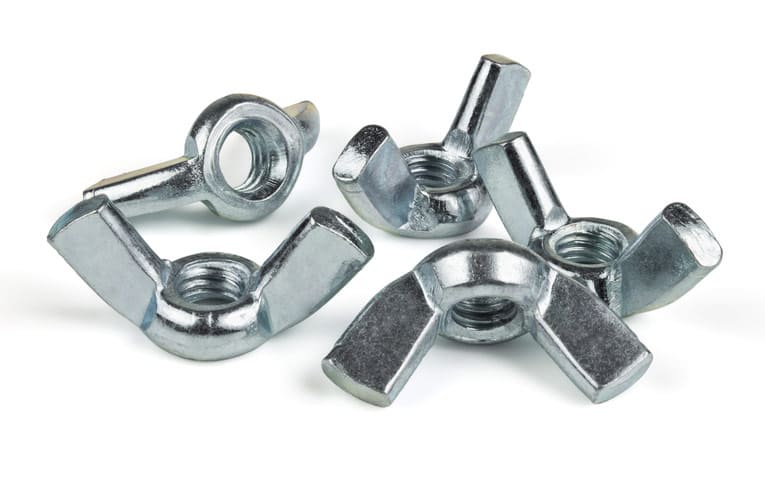We all know that nuts are manufactured in different forms like Square nuts, Hexagonal nuts, Ring nuts, cap nuts, cylindrical nuts, dome nuts, wing nuts, etc. Among all of these types of nuts, Hexagonal nuts or Hex nuts are one of the most widely used nuts. Hex nuts also come in different types like standard hex nuts and heavy hex nuts. In this article, we will learn about Heavy hex nuts and their dimensions.
What are Heavy Hex Nuts?
Heavy hex nuts are six-sided (hexagonal) internally threaded fasteners and larger versions of common/standard hex nuts. They are widely used for structural applications and because of this, heavy hex nuts are also known as structural nuts. Hex-heavy nuts are used for high-strength threaded fastening with large diameters. They are thicker and wider than standard hex nuts.
Similar to all other nuts, the heavy hex nuts are also used along with other fasteners mainly with a bolt to secure two or more materials together. To provide a long-lasting experience, heavy hex nuts are produced in zinc, plain, stainless steel, and galvanized finishes.
Paired with heavy hex bolts, these types of nuts are most common in construction and engineering applications. Hex-heavy nuts are available in various grades and selected based on the application.
Heavy Hex Nut Standards and Specifications
The most popular Heavy Hex nut standard is the ASME B18.2.2 which covers the complete general and dimensional data for the various types of inch series square and hex nuts. Widely used ASTM standards that cover the Heavey Hex Nuts are:
- ASTM A194
- ASTM A563
Heavy Hex Nut Dimensions
Heavy hex nut dimensions basically consist of three specific dimensions as listed below:
- Nut thickness (T)
- Width across flats (F), and
- Width across corners (C)
Hex heavy nut thickness, T is the overall distance from the top of the nut to the bearing surface measured parallel to the nut axis. Nut thickness also includes the thickness of the washer plate if available.
Nut’s width across flats, F is the distance between two opposite sides of the heavy hex nut measured perpendicular to the nut axis. Similarly, width across corners is the distance between two opposite corners as shown in Fig. below.

Heavy hex dimensions based on ASME B18.2.2 are given in table 1 below.
| Width Across Flats, F (inches) | Width Across Flats, F (inches) | Width Across Flats, F (inches) | Width Across Corners, C (inches) | Width Across Corners, C (inches) | Thickness, T (inches) | Thickness, T (inches) | Thickness, T (inches) | |
| Size | Basic | Max | Min | Max | Min | Basic | Max | Min |
| 1/2 | 7/8 | 0.875 | 0.850 | 1.010 | 0.969 | 31/64 | 0.504 | 0.464 |
| 5/8 | 1-1/16 | 1.062 | 1.031 | 1.227 | 1.175 | 39/64 | 0.631 | 0.587 |
| 3/4 | 1-1/4 | 1.250 | 1.212 | 1.443 | 1.382 | 47/64 | 0.758 | 0.710 |
| 7/8 | 1-7/16 | 1.438 | 1.394 | 1.660 | 1.589 | 55/64 | 0.885 | 0.833 |
| 1 | 1-5/8 | 1.625 | 1.575 | 1.876 | 1.796 | 63/64 | 1.012 | 0.956 |
| 1-1/8 | 1-13/16 | 1.812 | 1.756 | 2.093 | 2.002 | 1-7/64 | 1.139 | 1.079 |
| 1-1/4 | 2 | 2.000 | 1.938 | 2.309 | 2.209 | 1-7/32 | 1.251 | 1.187 |
| 1-3/8 | 2-3/16 | 2.188 | 2.119 | 2.526 | 2.416 | 1-11/32 | 1.378 | 1.310 |
| 1-1/2 | 2-3/8 | 2.375 | 2.300 | 2.742 | 2.622 | 1-15/32 | 1.505 | 1.433 |
| 1-5/8 | 2-9/16 | 2.562 | 2.481 | 2.959 | 2.828 | 1-19/32 | 1.632 | 1.556 |
| 1-3/4 | 2-3/4 | 2.750 | 2.662 | 3.175 | 3.035 | 1-23/32 | 1.759 | 1.679 |
| 1-7/8 | 2-15/16 | 2.938 | 2.844 | 3.392 | 3.242 | 1-27/32 | 1.886 | 1.802 |
| 2 | 3-1/8 | 3.125 | 3.025 | 3.608 | 3.449 | 1-31/32 | 2.013 | 1.925 |
| 2-1/4 | 3-1/2 | 3.500 | 3.388 | 4.041 | 3.862 | 2-13/64 | 2.251 | 2.155 |
| 2-1/2 | 3-7/8 | 3.875 | 3.750 | 4.474 | 4.275 | 2-29/64 | 2.505 | 2.401 |
| 2-3/4 | 4¼ | 4.250 | 4.112 | 4.907 | 4.688 | 2-45/64 | 2.759 | 2.647 |
| 3 | 4-5/8 | 4.625 | 4.475 | 5.340 | 5.102 | 2-61/64 | 3.013 | 2.893 |
| 3-1/4 | 5 | 5.000 | 4.838 | 5.774 | 5.515 | 3-3/16 | 3.252 | 3.124 |
| 3-1/2 | 5-3/8 | 5.375 | 5.200 | 6.207 | 5.928 | 3-7/16 | 3.506 | 3.370 |
| 3-3/4 | 5-3/4 | 5.750 | 5.562 | 6.640 | 6.341 | 3-11/16 | 3.760 | 3.616 |
| 4 | 6-1/8 | 6.125 | 5.925 | 7.073 | 6.755 | 3-15/16 | 4.014 | 3.862 |
Standard Hex Nuts vs Heavy Hex Nuts
The shape of both Standard hex nuts and heavy hex nuts are the same. However, there are some differences between a heavy hex nut and a standard hex nut as listed below:
- For the same nominal size, a finished hex nut or standard hex nut has a smaller width across the flats and corners than a heavy hex nut.
- The thickness of a heavy hex nut is slightly more as compared to a standard hex nut of the same nominal size.
- As heavy hex nuts are 1/8” larger across the flats than a standard hex nut for all sizes, Larger wrenches and sockets are required to install a heavy hex nut.
- As can be seen in ASTM A563, heavy hex nuts have a higher proof load strength compared to standard hex nuts.









Hi There,
A lot of individuals can benefit greatly from this article’s information on heavy hex nuts, their technical specifications, and the distinction between heavy hex nuts and hex nuts. This is an extremely interesting and helpful post. We appreciate you sharing this content. Continue to share…